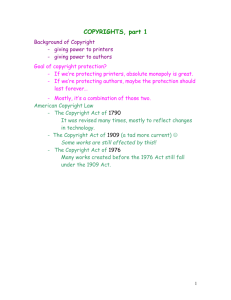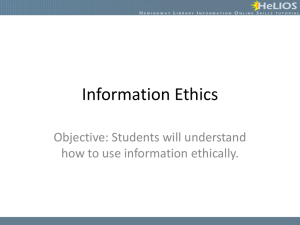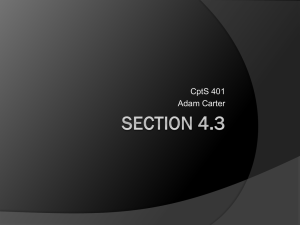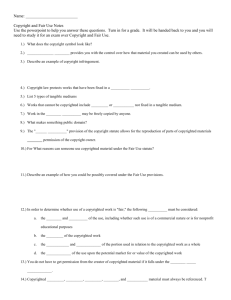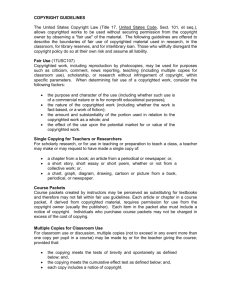Copying and distributing copyrighted materials
advertisement
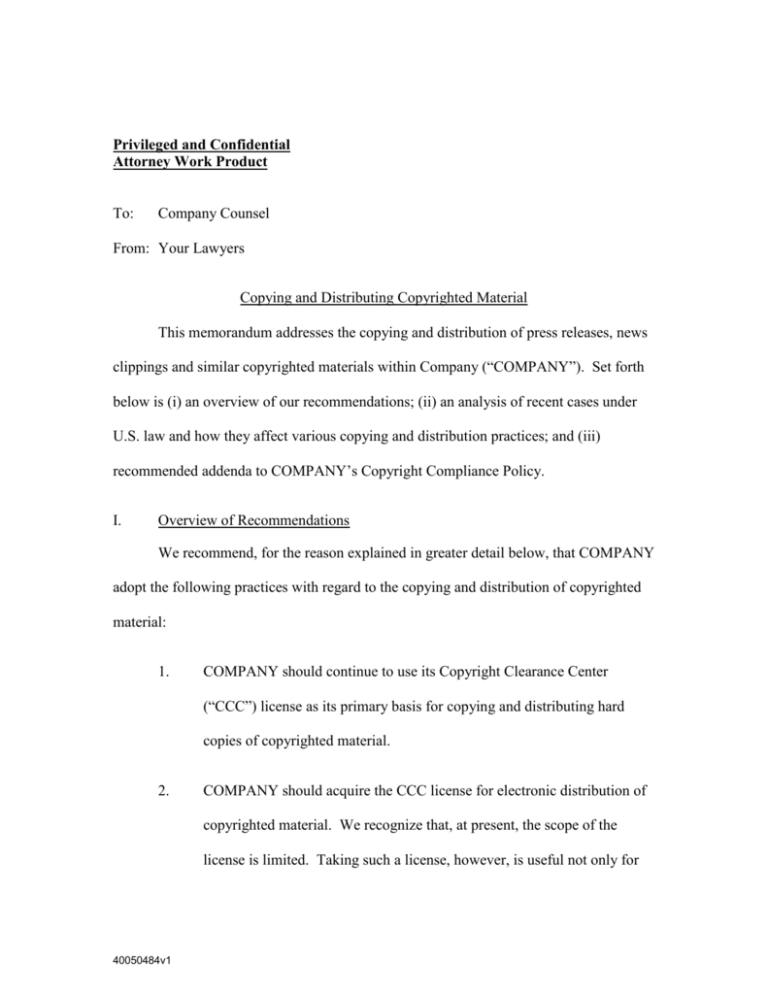
Privileged and Confidential Attorney Work Product To: Company Counsel From: Your Lawyers Copying and Distributing Copyrighted Material This memorandum addresses the copying and distribution of press releases, news clippings and similar copyrighted materials within Company (“COMPANY”). Set forth below is (i) an overview of our recommendations; (ii) an analysis of recent cases under U.S. law and how they affect various copying and distribution practices; and (iii) recommended addenda to COMPANY’s Copyright Compliance Policy. I. Overview of Recommendations We recommend, for the reason explained in greater detail below, that COMPANY adopt the following practices with regard to the copying and distribution of copyrighted material: 1. COMPANY should continue to use its Copyright Clearance Center (“CCC”) license as its primary basis for copying and distributing hard copies of copyrighted material. 2. COMPANY should acquire the CCC license for electronic distribution of copyrighted material. We recognize that, at present, the scope of the license is limited. Taking such a license, however, is useful not only for 40050484v1 what is specifically covers, but as evidence that COMPANY does not attempt to circumvent established market mechanisms, a useful fact if COMPANY has to rely on the fair use defense in the future. 3. For material that is frequently used by COMPANY employees, but not covered by a CCC license, COMPANY should acquire a license directly from an individual publisher. 4. In cases where a license for electronic distribution is not available or exigencies make it impossible to obtain a license in advance of a use, COMPANY should, as an alternative to acquiring licenses for both hard copy and electronic distribution, distribute such material by sending URLs, in the form of hyperlinks, to the pages of web sites on which copyrighted materials appear. A brief abstract of material may accompany the link. 5. COMPANY should prohibit employees from either scanning copyrighted material into electronic form or cutting and pasting electronic material for the purpose of further distributing that material electronically 6. Where CCC or individual publisher licenses are not available, but where fair use principles might permit copying and distribution, COMPANY should apply fair use principles consistently, across the corporation. For this purpose, a set of fair use guidelines should be developed and used by 2 40050484v1 the COMPANY in-house lawyers to whom questions regarding the use of copyrighted material would be directed. II. Applying the Fair Use Doctrine to Copying and Distribution Practices in Light of Recent Case Law The broad range of copying and distribution practices that might be undertaken by COMPANY employees generally can be classified into two categories: (a) traditional photocopying of hard copies and (b) electronic means. The Texaco decision (discussed in detail below) restricts some of the more common photocopying practices. Nevertheless, the opinion was written before widespread Internet access was available and therefore offers little express guidance on the practices of electronic copying and distribution of copyrighted materials. Moreover, even the decision in Texaco does not necessarily preclude all forms of photocopying for corporate uses, though many publishers and the CCC like to argue for the most restrictive reading of the holding. Whether accomplished by photocopying or by electronic media, COMPANY employees (like those of other large corporations) are likely to use copyrighted materials in several different ways: An individual may make a hard or electronic copy of an article for his or her personal use 3 40050484v1 An individual may distribute copies of copyrighted material to a few other people Copyrighted material may be distributed company-wide A compilation of copyrighted material may be distributed, usually on a division or company-wide basis. Whether these different types of copying and distribution practices – using both traditional and electronic means – are permissible under U.S. copyright law are discussed below. As copyright laws in other countries vary (particularly with respect to the existence and application of fair use or private use doctrines), any such practices undertaken outside the United States should be subject to a separate analysis under local law. A. Traditional Photocopying and Distribution Practices For years prior to the Second Circuit’s decision in American Geophysical Union v. Texaco Inc., 60 F.3d 913 (2d Cir. 1995), cert. denied, 516 U.S. 1005 (1995), many businesses assumed that all photocopying of copyrighted material for internal use, whether by only one person or for purposes of company-wide distribution, was a permissible fair use of such material. In its decision in Texaco, however, the Second Circuit held that institutional, systematic copying does not fall within the fair use doctrine, codified at Section 107 of the Copyright Act, because it increases the number of copies available to employees while avoiding the necessity of paying for license fees or additional subscriptions. In the court’s view, such copying could not qualify as a fair, 4 40050484v1 “transformative” use: the copied material was used for the same intrinsic purpose as the original. As a result of the Texaco decision, it has become reasonably clear that a company such as COMPANY may not make a copy of copyrighted material and then distribute that copy to the entire company, regardless of the means (hard copy or electronic) used to do so. The decision in Texaco did not address the entire spectrum of copying and distribution practices. Although the Second Circuit dealt with the copying of individual academic articles, for example, it did not consider whether the compilation of multiple articles from different sources into a clipping update might qualify as a “transformative” work constituting a fair use. It would be difficult for any single publisher to argue that such compilations affect the number of copies of the original work it otherwise would sell: the purpose of the clippings compilation is to collect, in one place, relevant articles from a wide variety of periodicals for which subscriptions already are in place. No single publisher offers a comparable product. Compare Itar-Tass Russian News Agency v. Russian Kurier, Inc., 153 F.3d 82, 94 (2d Cir. 1998) (copying of articles, sometimes including headlines, photographs and bylines, cut out of plaintiffs’ publication and pasted into defendants’ publication constitutes infringement under U.S. copyright law). Notwithstanding the economic logic of this argument, compilation of various articles into the clipping update is unlikely to be considered transformative, particularly if not accompanied by original textual analysis. See Basic Books, Inc. v. Kinko’s Graphics Corp., 758 F. Supp. 1522 (S.D.N.Y. 1991) (duplication of excerpts from books and 5 40050484v1 compilation into university course packets was not a fair use); see also Princeton University Press v. Michigan Document Services, 99 F.3d 1381 (6th Cir. 1996) (en banc) (same). Such a compilation arguably becomes more transformative if the articles are accompanied by an index and global analysis of the clips included, (i.e., “COMPANY was lauded around the country today for its announcement that . . .”). This type of work is more easily characterized as having a value apart from that represented by any individual article because it is created for the purpose of monitoring the news as a whole, rather than to benefit from the expression reflected in any individual article. The work involved in adding an index and abstract, however, may be deemed too time consuming. Moreover, we generally agree with the conclusion previously provided to COMPANY that (assuming a relatively bare bones index and abstract) the end product still may not be sufficiently transformed to tip the fair use scales in COMPANY’s favor. The copyright holder will still be able to argue that, although the entire compilation may be “transformative,” there has been no transformation of each individual article. Thus, although there may well be significant differences between such a compilation and the photocopies at issue in Texaco, for cost/benefit purposes the systematic internal distribution of photocopies of news clips should continue to be conducted under a CCC license. The Texaco decision also failed to address whether it was a fair use for an individual, acting on his or her own, to make a single copy of copyrighted material for his or her own personal use (e.g., for purposes of reading it on the train or for inclusion in a 6 40050484v1 personal file). The Texaco opinion specifically noted that it dealt with systematic, institutional photocopying, not “the question of copying by an individual, for personal use in research or otherwise (not for resale) . . . under the fair use doctrine or the de minimis doctrine, such a practice by an individual might well not constitute an infringement.” Texaco, 60 F.3d at 916. In such circumstances, the copying might not affect the number of subscriptions a company would otherwise take. At the same time, Texaco (and other cases) also narrows the scope of the fair use doctrine by suggesting that if a use is licensable (such as under the CCC license), there often will be a commercial harm to a publisher that would take an otherwise innocuous use outside the bounds of the fair use doctrine. As a practical matter, however, whether individual copying ultimately is or is not adjudicated fair use, it would be very difficult for any publisher to learn of and object to it. Thus, COMPANY does not risk significant exposure as a result of such individual copying. Where, however, the individual distributes the copy to a small group of individuals and, even more so, outside the company, the likelihood that such practices would be regarded as a fair use diminishes accordingly, especially since the CCC licenses such uses. As a precaution against any claim brought against COMPANY with respect to such individual photocopying practices, COMPANY should build a record of having reminded employees that copyright places limits on their copying practices. In addition to widespread (and perhaps regular) circulation of the Copyright Compliance Policy, a 7 40050484v1 record of COMPANY’s efforts to comply with the copyright law can readily be supplemented by posting a notice above every photocopying machine that states: Notice: The copyright law of the United States (Title 17 U.S. Code) governs the making of photocopies or other reproductions of copyrighted materials. The person using this equipment is liable for any infringement. Please consult the Company’s Copyright Compliance Policy to determine permissible copying practices. For similar reasons, COMPANY should establish a consistent, centralized set of fair use principles that can be applied by in-house counsel when approached by business people seeking advice on the limits of fair use (i.e., a use not expressly authorized by the Copyright Compliance Policy). Although the fact-specific nature of the fair use inquiry makes it difficult to prescribe a definitive set of rules in advance that would cover all circumstances, a use generally will be viewed as more “fair” if: • The copying does not reproduce the entire copyrighted work, but rather the smallest excerpt necessary to communicate the point; • The copy contains more than just the content of the copyrighted original work and has added material, such as comment or criticism, that puts the original in context; • The copy is used in a way that does not substitute for the original, allowing it to be characterized as serving a different market that does not impair the marketability of the copyrighted work. • The work being copied is likely to be – or to become – out of print, taken off a web site or otherwise hard to obtain using commercially available means. 8 40050484v1 B. Electronic Copying and Distribution Practices Although the availability of new technologies in recent years has made it dramatically easier (and more tempting) to copy and distribute copyrighted material, the same principles established by Texaco and outlined above apply to limit electronic copying and distribution practices. These practices would, at a minimum, include: (i) printing copyrighted material from a web site and distributing paper copies of that material; (ii) scanning copyrighted material to convert it into an electronic format and distributing it electronically, such as by email or by posting it on a company’s Intranet; (iii) downloading electronic files for personal storage and review at a later date (i.e., the online equivalent of “time shifting” with a VCR); (iv) forwarding to multiple third parties emails with embedded or attached copyrighted material; and (v) “cutting and pasting” copyrighted material located on a web site and distributing it by email or by posting it on an Intranet bulletin board. To the extent any of these practices result in widescale redistribution of copyrighted materials, they are likely to run afoul of copyright law for the same reasons Texaco and its progeny condemns them. For example, the Central District of California held that the operation of a web site on which members posted verbatim copies of plaintiff’s news articles did not constitute a fair use, even though these postings often were accompanied by potentially transformative comment and criticism. See Los Angeles Times v. Free Republic, 54 U.S.P.Q.2d 1453, 2000 WL 565200 (C.D. Cal. 2000). Citing Texaco, the court, in Free Republic, noted that the verbatim copies of the 9 40050484v1 copyrighted articles served as substitutes for the original articles located on plaintiffs’ web sites or in their newspapers and therefore a license was necessary. See also Religious Technology Center v. Netcom On-line Communication Services, Inc., 923 F. Supp. 1231 (N.D. Cal. 1995) (enjoining unauthorized posting of plaintiff’s copyrighted works on the Internet). As noted, however, Texaco also suggests (because it expressly reserved on the issue) that the practice of individuals making, from time to time, personal copies of copyrighted material may be justified either as a fair use or a de minimis use. This result seems particularly just in the online context, in which web sites change content on a weekly or even daily basis. There is, therefore, perhaps an even more compelling and legitimate need to make a single copy to preserve access to online material. The evanescent nature of online material makes it is less likely that the publisher of a newsoriented site can analogize its content to the hard copies of journals, such as those at issue in Texaco, that sit on the shelves in a company library. Therefore, COMPANY does not face significant exposure if an individual employee, or even if a small number of individual employees, make a single hard or electronic copy of copyrighted material found on a web site. Accordingly, an employee should be able to print out copyrighted material from a web site for his or her personal files, store a copy of a web page on a floppy disk or hard drive, or copy a web page onto a lap top for later review. Such practices are commonplace and, at this point, it well could be argued that an implied license might condone them, subject, of course, to 10 40050484v1 express terms of service to the contrary (see p. [12], infra.). Indeed, even the programming, by multiple employees, of their computers to search for and download relevant articles is unlikely to run afoul of the concerns of the Texaco court. It is probably not a fair use, however, for individuals to distribute widely the electronic copies that they may make from a web site. Were they to do so, the copy risks serving as a substitute for the original web site article, depriving the site operator of valuable hits. The ease of electronic redistribution also increases the risk that the recipient of the copyrighted material also will send it along, resulting in a further erosion of the fair use defense. A reasonably conservative policy, therefore, would place strict limits on the redistribution of copyrighted content from one employee to another, or to persons outside the corporation. Other than in narrow circumstances, such as an employee downloading material and transferring it to his or her secretary for filing purposes, COMPANY should discourage electronic redistribution of copyrighted content. This should be the rule even when the COMPANY employee is not the original downloader, as in the case of an unsolicited email that has attached or embedded copyrighted material. For a variety of 11 40050484v1 reasons, (some of which, as in the case of unsolicited emails, are equally important for computer security purposes) widespread redistributions should not be permitted.1 Before undertaking any copying of material found on a web site – even a single, personal copy – employees must also review the “Terms of Service” of the web site. The “Terms of Service” of many web sites where such content can be found closely mirror copyright law by prohibiting unauthorized reproductions and distributions but permitting limited copying for personal, noncommercial use. For example, nytimes.com provides that: All materials contained on this site are protected by United States copyright law and may not be reproduced, distributed, transmitted, displayed, published or broadcast without the prior written permission of The New York Times Company. You may not alter or remove any trademark, copyright or other notice from copies of the content. However, you may download material from The New York Times on the Web (one machine readable copy and one print copy per page) for your personal, noncommercial use only. 1 One practical problem with widespread intra-company distributions is that it will make it more difficult for COMPANY to take advantage of the safe harbor for service providers that is set forth in the Digital Millennium Copyright Act (the “DMCA”), 17 U.S.C. §512, which requires that the service provider [COMPANY] “not be aware of any facts or circumstances from which infringing activity is apparent.” 12 40050484v1 It is possible, however, that a web site’s “Terms of Service” may be more strict than copyright law and prohibit all copying of any kind. The “Terms of Service” may, for example, seek to restrict contractually any activities otherwise permitted by the fair doctrine, or by statute and interpretive case law. Although no court has specifically addressed whether a web site’s “Terms of Service” can contractually override the fair use exception to copyright infringement, courts generally have held that contracts expanding the rights of copyright owners are not preempted by copyright law. See, e.g., ProCD, Inc. v. Zeidenberg, 86 F.3d 1447 (7th Cir. 1996) (holding that shrinkwrap license prohibiting copying of uncopyrightable data not preempted by copyright law). In addition, the Uniform Computer Information Transactions Act (“UCITA”), recently sent to the states for adoption (and, to date, only adopted by Maryland and Virginia), may be read to permit mass market licenses to circumscribe fair uses in some circumstances, though the question of the enforceability of such license provisions is not free from controversy. For these reasons, a CCC license for electronic distribution is advisable if COMPANY wishes to conduct, electronically, the same sort of internal distribution of materials it has conducted via photocopies. Although the license does not yet cover a broad number of publications, the number of publishers covered by the license may increase significantly in the near future. Moreover, regardless of the current scope of coverage, taking such a license would allow COMPANY to defend itself, in any subsequent litigation, by arguing that it has not attempted to circumvent a “traditional, reasonable or likely to be developed” market. Texaco, 60 F.3d at 929. 13 40050484v1 C. Alternatives to Electronic Distribution of Copyrighted Content As an alternative, to fill the gaps in CCC’s current electronic coverage, COMPANY could consider negotiating such licenses directly with the publishers of any materials it finds desirable to circulate immediately on a regular basis. We recognize, however, that, quite apart from the expense of taking out such licenses, the administrative burden of identifying all the licenses that are desirable, and then negotiating and then maintaining them, may be considerable. For these reasons, it is, therefore, useful to consider whether new technologies such as the Internet, Intranets and email can be used to modify COMPANY’s current, hard copy distribution practices in a way that avoids the need for a license. For those materials that are found online, instead of distributing an entire article or a compilation of articles, COMPANY could electronically distribute (by email or by posting on a COMPANY Intranet bulletin board) URLs in the form of hyperlinks to the web site page that contains the relevant copyrighted material. An employee could then click on the link and view the article in its original location. Providing a link to a web site page does not constitute copyright infringement because (1) URLs are not copyrightable and (2) when a user activates the link he or she is viewing the page (assuming no frames are involved)2 within the scope of purposes for 2 The use of framing, in which the content of a web page appears on the user’s screen within a designated frame provided by another web site, may constitute copyright infringement and therefore should be avoided. See Washington Post v. Total News, Inc., 97 Civ. 1190 (PKL) (S.D.N.Y. complaint filed Feb. 20, 1997) (settlement 14 40050484v1 which the page was created. Moreover, as a practical matter, linking to a web site increases the number of users visiting the web site and accordingly the number of people viewing any advertising posted on the web site. There has been some debate to whether “deep linking” -- bypassing a web site’s home page and linking directly to an internal page of a web site that contains the specific article of interest -- is actionable. Those debates (and the only litigation on point) principally involve unfair competition claims that would not be presented by COMPANY’s adoption of the practice of transmitting URLs described above. In 1997, for example, TicketMaster filed a complaint objecting to Microsoft’s linking to Web pages deep within the TicketMaster site because such linking bypassed the advertising located on TicketMaster’s home page. See TicketMaster Corp. v. Microsoft Corp., No. 97-3055 (C.D. Cal. complaint filed Apr. 28, 1997). The parties settled, however, in January 1999, in a way that reportedly permitted Microsoft to maintain a link to TicketMaster’s home page, but not to internal pages of the web site. In a later deep linking case, TicketMaster Corp. v. Tickets.com, Inc., 2000 U.S. Dist. LEXIS 12987 (C.D. Cal. 2000), the District Court drew a distinction between copying the contents of a web page and copying a URL that directs a user to a specific web page, noting that reached prohibiting defendant from framing plaintiffs’ web sites); see also Futuredontics, Inc. v. Applied Anagramics, Inc., No. CV 97-6991 ABC (MANx), 1998 U.S. Dist. LEXIS 2265 (C.D. Cal. Jan. 30, 1998) (denying defendant’s motion to dismiss copyright claim, court held that it could not rule as a matter of law that defendant’s web site, which framed plaintiff’s web site, did not qualify as a derivative work). 15 40050484v1 reproducing a URL does not implicate copyright rights. “Except for the URL,” it said, “copying of the electronic bits which make up a page is copying [that] would violate the Copyright Act if not justified” by fair use. There is, however, a recent copyright case that happens to involve “deep link” functionality. In Kelly v. Arriba Soft Corp., 77 F. Supp. 2d 1116 (C.D. Cal. 1999), the court applied the fair use doctrine to determine whether the reproduction of photographs, located by a search engine in response to various user requests, was infringing. The photographs were reproduced as a result of responses to requests that a search engine “deep link” directly to pages of web sites containing the plaintiff’s copyrighted material. The court held that these reproductions were permissible because the practice did not cause any harm or adverse impact. It rejected, as not supported by any evidence, defendant’s argument that linking to an internal page of the web site, as opposed to the front or home page of the site, was harmful because users would be less likely to view all of the advertisements on the web site or view the entire web site’s promotional message. One difficulty in simply providing a link to articles on a web site is that they are updated throughout the day and, frequently, updated (and removed) on a daily basis. Thus, in addition to providing the link, COMPANY may consider also including in the distribution a brief abstract describing or summarizing the copyrighted material to which the employee is being directed. The abstract must be an original summary of the content of the copyrighted work; it may not merely copy a small portion of the article. See Nihon Keizai Shimbun, Inc. v. Comline Business Data, Inc., 166 F.3d 65 (2d Cir. 1999). The 16 40050484v1 abstract must not bear a “substantial similarity” to protected expression in the copyrighted work. It can communicate the facts contained in the copyrighted article, but cannot copy “the manner of expression, the author’s analysis or interpretation of events, the way he structures his material and marshals facts, his choice of words, and the emphasis he gives to particular developments.” Wainwright Securities Inc. v. Wall Street Transcript Corp., 558 F.2d 91, 95-96 (2d Cir. 1977). A two-sentence abstract focusing on the subject matter of the copyrighted article is well within the parameters of permissible conduct. III. Suggested Addenda To COMPANY’s Copyright Compliance Policy COMPANY’s Copyright Compliance Policy generally covers all of the important guidelines for the copying and distribution of copyrighted work, particularly with regard to such works covered by the CCC license. In addition, we recommend that COMPANY adopt the following addenda as part of its Copyright Compliance Policy to provide more specific guidelines for copying and distributing copyrighted works that are not covered by any CCC license. The amended Copyright Compliance Policy is attached hereto. 17 40050484v1
